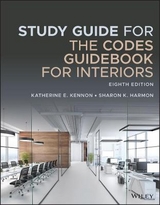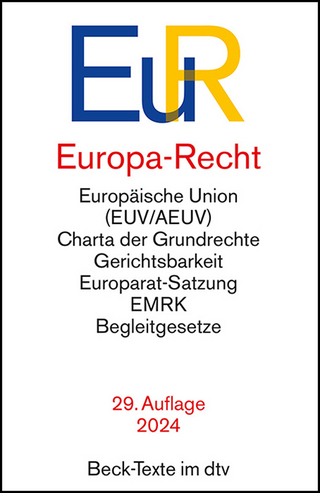
Study Guide for The Codes Guidebook for Interiors, Seventh Edition
John Wiley & Sons Inc (Verlag)
978-1-119-34317-2 (ISBN)
- Titel erscheint in neuer Auflage
- Artikel merken
This revised and updated seventh edition of the Study Guide for the Codes Guidebook for Interiors is an essential companion to The Codes Guidebook for Interiors, the industry's reference of choice, with complete coverage of the major codes and standards that apply to interior projects. This Study Guide includes term lists, practice questions, practical application exercises, code tables, checklists, and a book companion site featuring interactive checklists, helping designers and architects check their knowledge and comprehension from reading The Codes Guidebook for Interior chapters and prepare for the NCIDQ and ARE exams. Since The Codes Guidebook for Interiors text covers the latest requirements, standards, terminology, and federal regulations, including the 2015 ICC, the current ADA standards, and ICC/ANSI requirements as well as information on green construction, this companion study guide is a comprehensive measure of designers understanding and application of codes for interior projects. It can help design students learn and practitioners keep their skills up to date.
Because it is vital that designers and architects have an up-to-date working knowledge of the various codes involved with building interiors, whether during renovation or new construction, the study guide offers them an opportunity to:
Check their knowledge of the key terms of the industry
Test their working knowledge of codes using the practice questions and problem scenarios
Utilize the code tables during the design process
Employ the numerous checklists on proposed and real life projects to ensure complete compliance
The revised Study Guide is a useful companion to The Codes Guidebook for Interiors, the essential reference for all interior professionals. Check your understanding of the individual chapters as exam prep or even just as a self-test. For the designer, architect, or student, the Study Guide for The Codes Guidebook for Interiors is a must-have resource.
KATHERINE E. KENNON, AIA, is a licensed architect with nearly thirty years' experience in design for commercial, healthcare, and residential projects. As an adjunct instructor, she has taught courses on design, codes, accessibility, and interior/architectural history at various design programs in Tennessee where she lives. She has also presented seminars on codes and accessibility for design professionals at conferences and organizational meetings throughout the United States. SHARON K. HARMON has more than twenty-five years' experience in interior design and project management. Combining this with her strong interest in natural health, she now owns Life Design for Health, which helps people pursue a holistic approach to health and well-being.
Acknowledgments vii
Introduction ix
Part 1 Data Gathering 1
1.0 Data Gathering Techniques 2
1.1 Benchmarking 3
1.2 Brainstorming 6
1.3 Check Sheets 8
1.4 Checklists 10
1.5 Focus Groups 12
1.6 Statistical Sampling 14
Part 2 Data Analysis 17
2.0 Data Analysis Techniques 18
2.1 Alternatives Analysis 19
2.2 Cost Benefi t Analysis 24
2.3 Cost of Quality 27
2.4 Decision Tree 31
2.5 Earned Value Analysis 36
2.6 Infl uence Diagrams 41
2.7 Make-or-Buy Analysis 44
2.8 Performance Index 46
2.9 Regression Analysis 48
2.10 Reserve Analysis 51
2.11 Root Cause Analysis 55
2.12 Sensitivity Analysis 58
2.13 Stakeholder Analysis 63
2.14 SWOT Analysis 67
2.15 Technical Performance Analysis 70
2.16 Variance Analysis 72
2.17 What-If Analysis 74
Part 3 Data Representation 77
3.0 Data Representation Techniques 78
3.1 Cause-and-Effect Diagram 79
3.2 Control Charts 82
3.3 Flowcharts 87
3.4 Histograms 90
3.5 Logical Data Model 93
3.6 Mind Mapping 96
3.7 Probability and Impact Matrix 98
3.8 Resource Breakdown Structure 101
3.9 Responsibility Assignment Matrix 103
3.10 Scatter Diagrams 106
3.11 Stakeholder Mapping 108
Part 4 Estimating 111
4.0 Estimating Techniques 112
4.1 Analogous Estimating 113
4.2 Bottom-Up Estimating 116
4.3 Estimate at Completion 119
4.4 Estimate to Complete 123
4.5 Parametric Estimating 126
4.6 To-Complete Performance Index 128
4.7 Three-Point Estimating 131
4.8 Variance at Completion 134
Part 5 Interpersonal and Team Skills 137
5.0 Interpersonal and Team Skills 138
5.1 Confl ict Management 139
5.2 Decision Making 145
5.3 Nominal Group Technique 151
5.4 Problem Solving 153
Part 6 Other Techniques 157
6.0 Other Techniques 158
6.1 Context Diagram 159
6.2 Critical Path Method 161
6.3 Funding Limit Reconciliation 170
6.4 Inspection 172
6.5 Leads and Lags 174
6.6 Precedence Diagramming Method 177
6.7 Prompt Lists 181
6.8 Prototypes 184
6.9 Resource Optimization 186
6.10 Rolling-Wave Planning 189
6.11 Schedule Compression 192
Appendix: Case Study Scenarios 197
Index 203
| Erscheinungsdatum | 03.03.2018 |
|---|---|
| Verlagsort | New York |
| Sprache | englisch |
| Maße | 217 x 271 mm |
| Gewicht | 426 g |
| Themenwelt | Recht / Steuern ► EU / Internationales Recht |
| Technik ► Architektur | |
| Technik ► Bauwesen | |
| ISBN-10 | 1-119-34317-8 / 1119343178 |
| ISBN-13 | 978-1-119-34317-2 / 9781119343172 |
| Zustand | Neuware |
| Haben Sie eine Frage zum Produkt? |
aus dem Bereich



